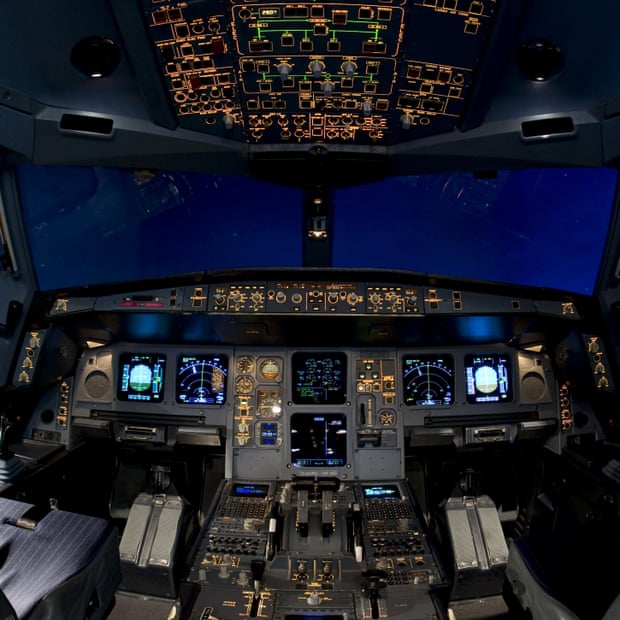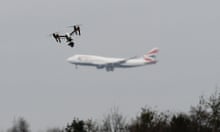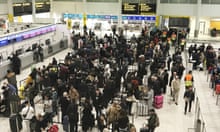Pilotless planes would save airlines $35bn (£27bn) a year and could lead to substantial fare cuts – if passengers were able to stomach the idea of remote-controlled flying, according to new research.
The savings for carriers could be huge, said investment bank UBS, even though it may take until the middle of the century for passengers to have enough confidence to board a pilotless plane. UBS estimated that pilots cost the industry $31bn a year, plus another $3bn in training, and that fully automated planes would fly more efficiently, saving another $1bn a year in fuel.
Quick GuidePilotless planes
Show

Is the pilotless passenger plane feasible?
The use of commercial and military drones shows the technology for pilotless plane travel exists and is in regular use. The most common type of passenger aircraft in the world, which is planes made by Boeing and Airbus, rely heavily on computers that do much of the pilots’ work. This form of flight is known as “fly by wire”. Meanwhile, auto-landing as well as conventional auto-pilot have been in place for decades. Control towers at airports are likely to become a thing of the past, with plans at London City airport to relay HD imagery to a site in Hampshire.
Is fly by wire technology safe?
Flying by airplane has never been safer thanks to considerable improvements in technology and design (and airport security). According to the International Air Transport Association, the airline industry trade body, there were 1.25 accidents per million jet flights last year – lower than the five-year average of 1.46 (which was already at a very low level). But the interaction between an automated system and a pilot can cause fatalities when it goes wrong and was a key factor in the Air France Flight 447 crash, which claimed 228 lives in 2009 and was the subject of an interesting Vanity Fair article.
What do the pilots think?
Steve Landells, flight safety specialist for the British Airline Pilots Association, says: “We have concerns that in the excitement of this futuristic idea, some may be forgetting the reality of pilotless air travel. Automation in the cockpit is not a new thing – it already supports operations. However, every single day pilots have to intervene when the automatics don’t do what they’re supposed to. Automated aircraft would be at risk of cyber-attacks. The system would need to be airtight to ensure those with malicious intent couldn’t take control.”
Passengers could benefit from a reduction in ticket prices of about a tenth, the report said. “The average percentage of total cost and average benefit that could be passed onto passengers in price reduction for the US airlines is 11%,” it said, although the savings in Europe would be less, at 4% on average but rising to 8% at Ryanair.
Aircraft costs and fuel make up a much larger proportion of costs at airlines than pilot salaries, but UBS said profits at some major airlines could double if they switched to pilotless.
More than half of the 8,000 people UBS surveyed, however, said they would refuse to travel in a pilotless plane, even if fares were cut.
“Some 54% of respondents said they were unlikely to take a pilotless flight, while only 17% said they would likely undertake a pilotless flight. Perhaps surprisingly, half of the respondents said that they would not buy the pilotless flight ticket even if it was cheaper,” the report said.
It added, however, that younger and more educated respondents were more willing to fly on a pilotless plane. “This bodes well for the technology as the population ages,” it said.
Industry experts predict intense passenger resistance to pilotless planes. Chris Tarry, an aviation expert, said: “This is such a long way into the future. It’s going to be a very brave airline that takes its pilots off planes. What is a cutomer’s number one concern? That they get you there safely.
“There has been a lot of automation, and a number of landings at Heathrow are now on auto-land. But operating a drone is a very different thing to putting passengers on board and getting them off safely,” he said.
Drone technology has advanced rapidly in recent years, with all the major plane manufacturers testing fully-automated jetliners.
Two weeks ago Airbus revealed that trials of its jet-engined Sagitta “unmanned aerial vehicle” had been successfully completed. In a seven-minute demonstration flight in South Africa, the “unmanned jet-propelled demonstrator … flew completely autonomously … on a pre-programmed course,” the company said in a statement.
Boeing told reporters at the Paris airshow in June that it was testing pilotless aircraft in simulators and that artificial intelligence systems could replace many of the decisions currently taken by pilots.
Commercial jets can already take off, cruise and land using computer technology, enabling planes to land at some airports even in foggy conditions. The number of pilots on a standard passenger plane has dropped from three to two in recent years.
Military technology is further advanced. The US navy managed to take off and land a fighter jet on an aircraft carrier in July 2013.
UBS said one path toward pilotless aircraft will see airlines move to one pilot per plane.
“In commercial flights, if the move from two to zero pilots may be too abrupt over the next 10 to 20 years, we could see first a move to having just one pilot in the cockpit and one remotely located on the ground, particularly on flights below six to seven hours [to be under pilots’ fatigue]. Indeed, today’s drones are controlled by remotely based operators.”
Ryanair boss Michael O’Leary said in 2010 that he would seek permission from authorities to fly with one person in the cockpit, saying the second pilot was only there to “make sure the first fella doesn’t fall asleep and knock over one of the computer controls”.
UBS said cargo would be the first to go pilotless. “Unlike passengers, cargo is not concerned with the status of its pilots [human or autonomous]. For this reason, pilotless cargo aircraft may happen more swiftly than for passengers. In addition, we believe that the 24-hour nature of much of cargo flights [often taking off or landing in the late and early hours] may be well suited to artificial pilots – with the problems of sleeping hours less of an issue.”
There are estimated to be about 20,000 commercial jet pilots in the UK, but in the medium term there in no threat to their jobs from pilotless aircraft.
On the contrary, airlines’ demand for pilots is soaring thanks to the rise of budget airlines and the huge increase in the number of commercial flights in Asia. “The real challenge for the industry right now is to train more pilots, not get rid of them,” Tarry said.









Comments (…)
Sign in or create your Guardian account to join the discussion